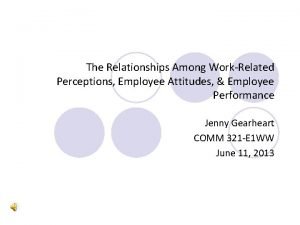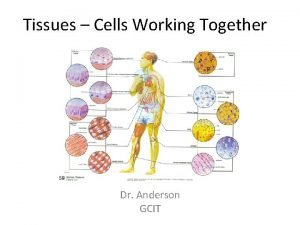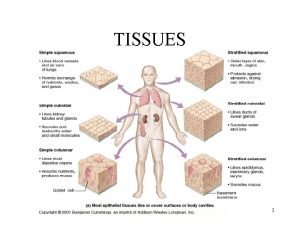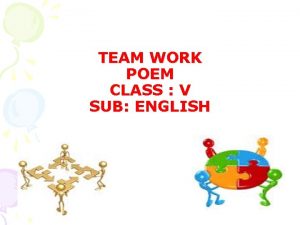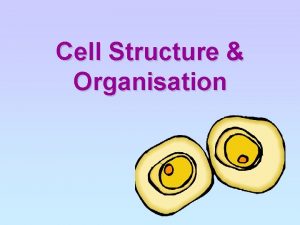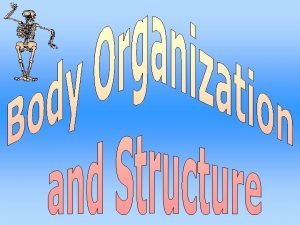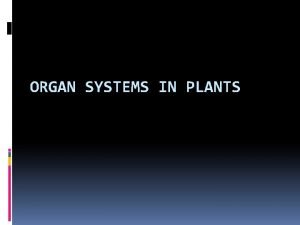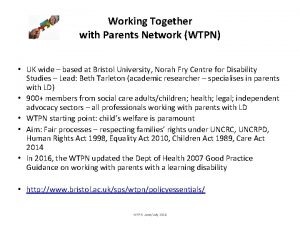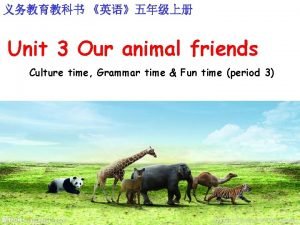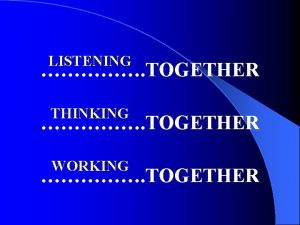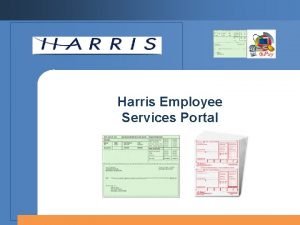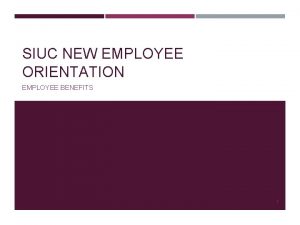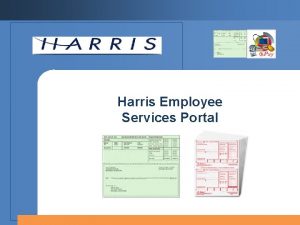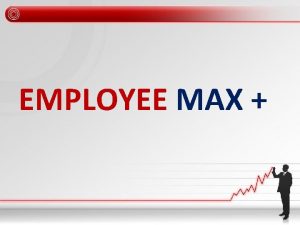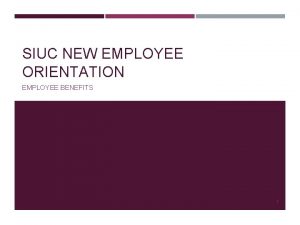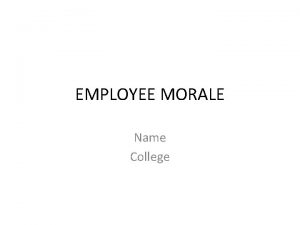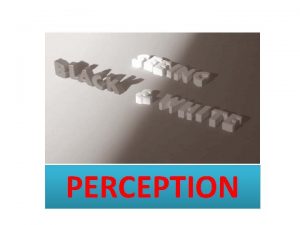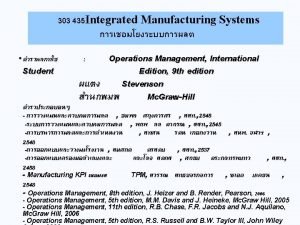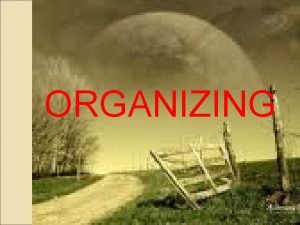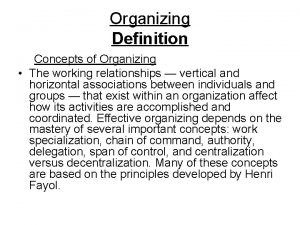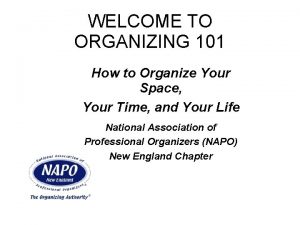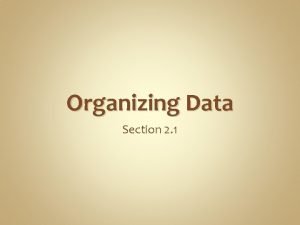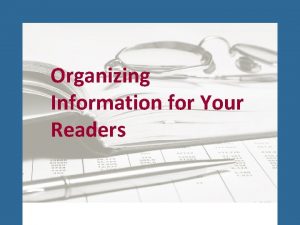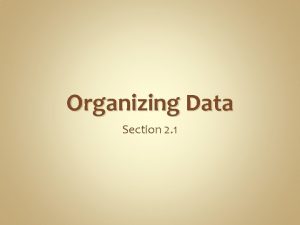ORGANIZING 1 Organizing Organize of employee working together























- Slides: 23

ORGANIZING 1

Organizing Organize of employee working together under a division of labor & a hierarchy of authority to achieve a common goal. - The 2 nd managerial function after planning process. - Number of workers / require a supervisor. - Organizations facilitate greater accomplishment of work by groups. - Manager develops order, promotes cooperation among workers, and fosters productivity - Major component: position, task responsibilities, & Relation ships. 2

Organization involves: 1. Defining the agency’s mission & objectives 2. Establishing policies & plans. 3. Clarifying the activities necessary to meet the objectives. 4. Organizing for best utilization of available human & material resources. 5. Delegating the responsibility & authority to appropriate personnel. 6. Grouping personnel vertically & horizontally through information & authority relationships 3

Organizational structure: 1. Organizational structure provides the formal framework in management process. 2. Organizational structure should provide an effective work system, & should consequently foster job satisfaction. 4

Informal & formal organization structures agencies: 1) Informal organization: personal & social relationships don't appear on the organizational chart. - Based on personal relationships rather than positional authority. - Provides social satisfaction, & may gain recognition. - Informal authority is not charged through organizational assignment. - Authority comes from the follower’s natural respect for a colleague’s knowledge and abilities - Provides social control of behavior. 5

2) Formal organization structures: Formal organizational structure: executive decision as a result of planning. The relationships among people and their positions can be diagramed. Describes positions, task responsibilities and relationships. 6

Nursing Department Utilize one of the Following Structural Patterns A- Line organization and staff organization: Most common structures in large health care facilities: - Organization’s structure commonly draw in an organization chart. - Line positions shown by either horizontal or vertical unbroken lines. - Horizontal unbroken lines represent communication between similar power but different functions 7

Vertical unbroken lines between positions means formal paths of communication & authority. - Greatest decision making and authority persons are located at the top, and the least are at the bottom. *Dotted or broken lines on the organization chart: - Represent staff position. - (advisory, provides information and assistance 8

Disadvantages of formal design: 1. Often produce monotony and alienate workers. ﺭﺗﺎﺑﺔ ﻭﺗﻨﻔﻴﺮ 2. Adherence to chain of command restricts upward communication (Going outside of the chain of command for upward communication inappropriate) 9

B- Functional structure: Employees are grouped: similar tasks in same group, similar group in the same department, & similar departments reporting to the same manager. Ex. All nursing tasks are under nursing service. CEO Chief executive officer Nursing Dietary Pharmacy Storeroom 10

* Advantages of functional organizations: - They use resource efficiently. - Do not duplicate tasks. - Simplify training. (common tasks grouped together for economy of scale). *Disadvantages: - Poor coordination across functions. - Response time is slower. 11

C- Dual management: Separates technical & administrative responsibilities. - One hierarchy for technical professionals make technical decisions, & another hierarchy for supervisors make decisions about management issues e. g. personnel and budget. - This dual hierarchy gives equal status to managers and technical professionals. It provides job description for each hierarchy. 12

D- Self – Contained unit structure������ : * Functions needed to produce a service are grouped together in an autonomous division. E. g. ( large institution) Strengths: Each division has its specialty & high client satisfaction can be achieved. High employees coordination across functions occurs to meet unit goals & reduce conflict. weaknesses: - Coordination across product lines is difficult. division operate independently. - Each service line has its own nursing staff and competes with other service lines. 13

E- Matrix structure: Structure has a formal vertical as well as horizontal chain of command. Separate executives are responsible for each side of the matrix. Heads of Departments may receive conflicting demands from the matrix managers and often must resolve the conflict themselves. 14

Advantages: (matrix structure): - Strong contact between staff of different divisions. Disadvantages: 1. Dual authority frustrating and confusing for managers and employees in dept. 2. Need excellent interpersonal skills for involved managers 3. Time-consuming because frequent meetings are required to resolve conflicts 15

Organizational concepts: Charts: drawing shows how the parts of an organization are linked. - It depicts the formal organizational relationships, Areas of responsibility & accountability, and channels of communication 16

Decentralization Versus Centralization: Centralized: decision making done by a manager at the top of the hierarchy Decentralized: decision making diffuses throughout the organization, and allow problem solving at the level at which they occur. 17

Advantages of decentralization: 1. Increases morale & promotes interpersonal relationships 2. Encourage informality and democracy in management. 3. Facilitate local decision making by Managers & others. 4. Develops managers by allowing them to manage. 5. Increase flexibility. 6. Releases top managers from the routine 18

Disadvantages of decentralization 1. Divisions may become individualized and competitive and work against the best interests of the organization. ﻷﻬﺪﺍﻑ ﺍﻟﻌﺎﻣﺔ ﻟﻤﺼﻠﺤﺔ ﺿﻴﻘﺔ 2. ﺗﻀﺤﻴﺔ ﺑﺎ Increase costs, need more manager and large staffs 3. Division managers may not inform top manager of their problems. 19

Delegation Work done through others to accomplish organizational goals From superior to subordinate. Delegation has two legs (Responsibility & Authority) Delegation increase subordinate's motivation & commitment to accomplish goals. The manager concentrates on the accomplishment of overall goals and objectives rather than the day-to-day details - In delegation the manager delegate (authority & the power) 20

Departmentalization: Subdivide of the organizational structures. Managers specialize within limited ranges of activity. 1. Departmentalization by function 2. Departmentalization by production 3. Departmentalization by customers 4. Departmentalization by geographical territories. 21

Authority: - The official power to act. Given by the organization to direct the work of others. - A manager may have the authority to hire, fire, or discipline others. • Responsibility: is a duty or an assignment. • Accountability: morally internalizing responsibility. It is agreement to accept the consequences of your actions. 22

23
 Employee attitudes and employee performance
Employee attitudes and employee performance Prinsip dasar proses pengerjaan panas yang benar adalah
Prinsip dasar proses pengerjaan panas yang benar adalah Hot working
Hot working Hot working and cold working difference
Hot working and cold working difference Machining operations
Machining operations Working hard vs working smart
Working hard vs working smart Working together to achieve a common goal
Working together to achieve a common goal Tissues working together
Tissues working together Tissues are groups of similar cells working together to
Tissues are groups of similar cells working together to Working together rafael and salvador
Working together rafael and salvador Acrostic poem for team
Acrostic poem for team Tissues are groups of similar cells working together to:
Tissues are groups of similar cells working together to: Working better together
Working better together Root hair cells
Root hair cells Churches and schools working together
Churches and schools working together Working together to safeguard children 2018
Working together to safeguard children 2018 Teachers and teacher aides working together
Teachers and teacher aides working together Working better together
Working better together Similar cells working together
Similar cells working together Plants organs that work together
Plants organs that work together Paraprofessionals and teachers working together
Paraprofessionals and teachers working together Teamwork
Teamwork Wtpn
Wtpn Teamwork animals working together
Teamwork animals working together
